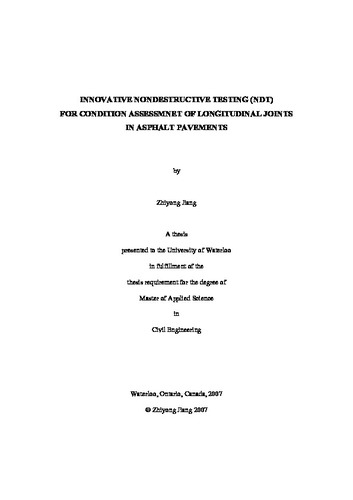| dc.description.abstract | The failure of longitudinal construction joints is one of the critical factors causing accelerated pavement deterioration. Poor-quality longitudinal construction joints are often characterized by a difference in elevation between adjacent lanes or by unraveling of the hot mix asphalt (HMA). Current wave-based non-destructive testing (NDT) methods are efficient and economical for the evaluation of material properties. In this thesis, an innovative surface wave testing technique for condition assessment of longitudinal construction joints in asphalt pavements is presented. This method enables reduction of the number of cores required for large-strain testing and provision of a more uniform quality assessment of longitudinal joints as well as the relative condition of the asphalt pavements. The technical development is based on a theoretical study of the wave attenuation mechanisms and on the reported deficiencies in current seismic wave-based methods.
Traditionally, the use of ultrasonic testing to determine small-strain elastic property for asphalt concrete was uniquely based on the measurement of wave velocity. However, isolated use of wave velocity does not provide complete information of the materials strength because of the different variables that affect the strength-velocity relationship. Therefore, it is necessary to complement velocity data with independent information such as the change in attenuation and frequency content of the propagating pulse.
The existing deficiencies in current seismic wave-based methods were addressed to improve reliability, accuracy and consistency for asphalt concrete material characterization in the laboratory and in the field. Refined and improved signal processing techniques were used to overcome the shortcomings in the existing wave-based methods that contribute to uncertainties in the interpretation of test results. To capture more information from a wave, the signal was analyzed in the time and frequency domains. The basic analyses included a simple method such as peak to peak amplitude of the first cycle of arriving wave, and complex methods such as maximum magnitude and area of corresponding frequency spectrum through Fourier transform. A novel approach based on wavelet transform of the signal was presented, which provides an alternative method to determine wave characteristics.
Material characterization tests (experiment Phase I) were carried out to study the relationship between the wave characteristics obtained from UPV test and the quality of the asphalt concrete specimens prepared in the laboratory. The specimens were identical in terms of aggregate and asphalt binder ratio, but varying in volumetric properties produced by different compaction efforts. The specimen quality was determined using two methods: 1) the traditional method using density measurement and 2) an innovative approach using dynamic modulus which is recommended by the Federal Highway Administration (FHWA) for use as a fundamental material property for characterizing Superpave mixes (Witczak, et al., 2002; Bonaquist et al., 2003; Christensen et al., 2004). The measured wave characteristics showed excellent correlations (R2 > 0.9) with the fundamental properties of the mix. The results revealed that the wave amplitude parameters as the condition index have the potential to provide a reliable assessment of the quality of HMA mixtures. The finding is very critical to moving the technology forward in the right direction, and form an important basis for the experiment Phase II.
Experiment Phase II investigated the feasibility and effectiveness of using the wave characteristics identified in experiment Phase I to assess the condition of longitudinal construction joints. Particular attention was given to examining the sensitivity of the wave-based technique to different types of construction joints. For this purpose, three types of construction joints (good, fair and poor) were fabricated in the laboratory and identified using the wave-based technique. The research was intended to develop a suitable test procedure for condition assessment the longitudinal joints in asphalt pavement in the field. The data from experiment Phase II revealed that the wave-based technique enables assessment of not only the quality of different types of longitudinal construction joints but also the relative condition of asphalt pavements. | en |

